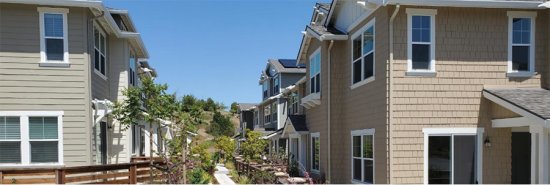 | | | One example of multi-unit housing Photo provided | | | | | | California state law is requiring all cities and towns to up their housing quota during the sixth cycle Housing Element period between 2023-31. As municipalities grapple with the Regional Housing Needs Allocation (RHNA), it has been determined by the Association of Bay Area Governments (ABAG) that Moraga must come up with 1,118 units to fulfill its quota. This figure is nearly five times higher than the 229 units required during the fifth cycle between 2015-23.
 The March 2 joint meeting between the town council and planning commission was called to provide staff with rezoning possibilities and where to focus on prospective housing sites. According to the staff report by Planning Director Afshan Hamid and Barry Miller of Barry Miller Consulting, "The availability of housing sites is one of the major factors considered by the state of California when they review the Housing Element. If the state finds that Moraga does not have adequate sites to meet the Town's `fair share' of the region's housing needs, it will not certify the document. Cities and towns without certified housing elements are subject to fines, penalties, litigation, and even the potential loss of local control over planning and building decisions."
The March 2 joint meeting between the town council and planning commission was called to provide staff with rezoning possibilities and where to focus on prospective housing sites. According to the staff report by Planning Director Afshan Hamid and Barry Miller of Barry Miller Consulting, "The availability of housing sites is one of the major factors considered by the state of California when they review the Housing Element. If the state finds that Moraga does not have adequate sites to meet the Town's `fair share' of the region's housing needs, it will not certify the document. Cities and towns without certified housing elements are subject to fines, penalties, litigation, and even the potential loss of local control over planning and building decisions."
 Of the 1,118 necessary units 318 are very low-income units, 183 are low-income units, 172 are moderate-income units, and 445 are above moderate-income units. More than 100 sites within town were evaluated with staff sending out letters to hundreds of property owners where potential new housing could be a considered. It was also determined that there were no viable sites outside of the Moraga Center Specific Plan and Rheem areas for zoning to a higher density. However, depending on the type of housing and its usage, Saint Mary's College could conceivably be included as imaginable new housing sites. Also, any projects that are currently in developmental stages are acceptable by RHNA standards.
Of the 1,118 necessary units 318 are very low-income units, 183 are low-income units, 172 are moderate-income units, and 445 are above moderate-income units. More than 100 sites within town were evaluated with staff sending out letters to hundreds of property owners where potential new housing could be a considered. It was also determined that there were no viable sites outside of the Moraga Center Specific Plan and Rheem areas for zoning to a higher density. However, depending on the type of housing and its usage, Saint Mary's College could conceivably be included as imaginable new housing sites. Also, any projects that are currently in developmental stages are acceptable by RHNA standards.
 There are zoning policy issues that will have to be revisited in order to increase Rheem Center's maximum density in R-20 from 20 to 24 units per acre. The mixed-use and multi-family residential areas of the MCSP would also need to see a density increase to 24 dwelling units per acre. Additionally, many areas are not even zoned for residential housing.
There are zoning policy issues that will have to be revisited in order to increase Rheem Center's maximum density in R-20 from 20 to 24 units per acre. The mixed-use and multi-family residential areas of the MCSP would also need to see a density increase to 24 dwelling units per acre. Additionally, many areas are not even zoned for residential housing.
 Council members and planning commissioners agreed that Rheem Center is probably the best first choice for new housing in that its close proximity to SMC wouldn't add too much traffic to the town's main corridors, and it would allow for three evacuation routes in the event of an emergency. SMC as a choice for RHNA housing should also be explored and would provide a win-win scenario with regards to more student participation within the Rheem Shopping Center, thereby increasing the much sought after town-gown relationship. MCSP was recognized as a necessary source of additional housing, but with less enthusiasm.
Council members and planning commissioners agreed that Rheem Center is probably the best first choice for new housing in that its close proximity to SMC wouldn't add too much traffic to the town's main corridors, and it would allow for three evacuation routes in the event of an emergency. SMC as a choice for RHNA housing should also be explored and would provide a win-win scenario with regards to more student participation within the Rheem Shopping Center, thereby increasing the much sought after town-gown relationship. MCSP was recognized as a necessary source of additional housing, but with less enthusiasm.
 The town reported that over 700 residents had responded to the housing survey as of March 9. Taking all considerations and suggestions into account, staff will continue to move forward and conduct future meetings and updates that include the community's input. For more information visit: www.makemoragahome.org.
The town reported that over 700 residents had responded to the housing survey as of March 9. Taking all considerations and suggestions into account, staff will continue to move forward and conduct future meetings and updates that include the community's input. For more information visit: www.makemoragahome.org. |
